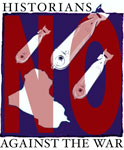Some Thoughts for the HAW Panel Tomorrow on War and the Economy
From 4:30 to 5:30 p.m. tomorrow in the Empire Ballroom East of the Sheraton New York, 7th Ave. and 53rd St., HAW members and friends will participate in a roundtable: "One Faltering Economy
and Two Wars: What Can Historians Contribute?
Unfortunately, I can’t be there. While I’m sure there will no shortage of topics, I hope they will include the widely believed theory (at least among my students) that “wars have been good for the economy” in American history.
Variants of this thesis can be found among across the political spectrum. On the right, neocon Conrad Black argues that World War II “had restored prosperity after the free market had failed.” On the left, Paul Krugman similarly writes: “There's nothing magic about spending on tanks and bombs rather than roads and bridges. The reason World War II worked more effectively than the WPA [in terms of promoting economic growth] as that it was *bigger.*” While Krugman might prefer that this “bigger” spending be on roads and bridges, rather than bombs, this does not change the fact he still accepts the overall premise that spending on wars can be good for the economy. If anyone should have greater reason to call this theory into question, it is antiwar historians.
A good place to start are the works of Robert Higgs on war and the economy. Few historians have provided a more powerful response to the Krugman/Black thesis. Higgs examines the most commonly measures of wartime prosperity and finds them wanting. He makes a compelling case that genuine prosperity did not begin to return until the wartime demoblization of 1945 and 1946. Higgs followed in the tradition of Thomas Cochran who in 1961 had convincingly challenged the thesis of Charles Beard that the Civil War had spurred industrialization.
Variants of this thesis can be found among across the political spectrum. On the right, neocon Conrad Black argues that World War II “had restored prosperity after the free market had failed.” On the left, Paul Krugman similarly writes: “There's nothing magic about spending on tanks and bombs rather than roads and bridges. The reason World War II worked more effectively than the WPA [in terms of promoting economic growth] as that it was *bigger.*” While Krugman might prefer that this “bigger” spending be on roads and bridges, rather than bombs, this does not change the fact he still accepts the overall premise that spending on wars can be good for the economy. If anyone should have greater reason to call this theory into question, it is antiwar historians.
A good place to start are the works of Robert Higgs on war and the economy. Few historians have provided a more powerful response to the Krugman/Black thesis. Higgs examines the most commonly measures of wartime prosperity and finds them wanting. He makes a compelling case that genuine prosperity did not begin to return until the wartime demoblization of 1945 and 1946. Higgs followed in the tradition of Thomas Cochran who in 1961 had convincingly challenged the thesis of Charles Beard that the Civil War had spurred industrialization.
Labels: civil war, economy, Krugman, World War II

